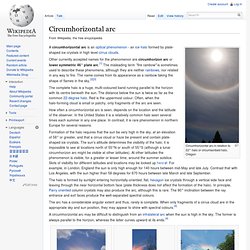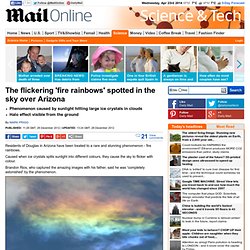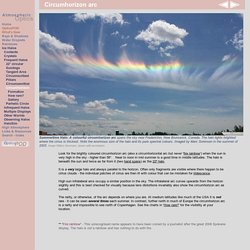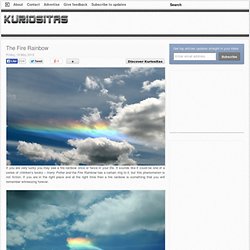

Circumhorizontal arc. Circumhorizontal arc in relation to 22° halo or circumscribed halo, Oregon Other currently accepted names for the phenomenon are circumhorizon arc or lower symmetric 46° plate arc.[1] The misleading term "fire rainbow" is sometimes used to describe these phenomena, although they are neither rainbows, nor related in any way to fire.

Jim Block Photography. An amazing light show appeared, faded, then reappeared in greater glory along I-89 in the general area of Grantham, NH yesterday morning.

Jann and I were “car pooling”—I had an assignment to photograph a yoga teacher, and Jann would drop off a quilt to be quilted in Newport on the way home. Jann first noticed a single sun dog. She made a few photos through a very dirty window made worst by the glare of the brilliant sun. I pulled over made a few quick photos and then we resumed our drive as the sun dog faded. I feared being late—I needed to meet and talk with the instructor before class started. But the show was far from over—now there were a pair of dogs (bright spots on each side of the sun at the elevation of the sun) as well as a faint 22 degree halo through them. From “Kaleidoscope Sky” by Tim Herd, a 22 degree halo is produced by the refraction of light through faces of ice crystals. 'I didn't think something like this could exist': The incredible fire rainbows spotted over Arizona. Phenomenon caused by sunlight hitting large ice crystals in cloudsHalo effect visible from the ground By Mark Prigg Published: 11:28 GMT, 28 December 2012 | Updated: 13:24 GMT, 28 December 2012 Residents of Douglas in Arizona have been treated to a rare and stunning phenomenon - fire rainbows.

Caused when ice crystals splits sunlight into different colours, they cause the sky to flicker with colour. Brandon Rios, who captured the amazing images with his father, said he was 'completely astonished' by the phenomenon. Circumhorizontal Arc. The photos below were taken on Tuesday May 15 during the afternoon.

I contacted Dr. Les Cowley (an optics specialist) to explain the photos below. Here is what he had to say. The first 2 photos are ice halos – circumhorizontal (preferred circumhorizon) arcs. There is a widespread Internet myth that these are very rare and on those sites they are erroneously and misleadingly called ‘fire rainbows’. Taken by Kevin Bublitz Taken by Yeni Klemesrud Here is what Dr.
This photo is much more interesting and its a relatively rare shot. Fire Rainbow. Interesting and Curious Facts. A beautiful work of nature, fire rainbows are not a common sight.

Fire rainbows are circumhorizon arcs commonly known as CHA in scientific language. Fire rainbows occur in cirrus clouds which are wispy and thin. For this incredible sight the cirrus clouds should be at 20000 feet height with sun at 58 degrees. The amount of ice crystals in the clouds need to be appropriate and properly aligned for the light to pass through it. Circumhorizon arc. Look for the brightly coloured circumhorizon arc (also a circumhorizontal arc but never 'fire rainbow') when the sun is very high in the sky - higher than 58°.

Near to noon in mid summer is a good time in middle latitudes. The halo is beneath the sun and twice as far from it (two hand spans) as the 22º halo. It is a very large halo and always parallel to the horizon. Often only fragments are visible where there happen to be cirrus clouds - the individual patches of cirrus are then lit with colour that can be mistaken for iridescence. Circumhorizontal Arc. The Fire Rainbow. If you are very lucky you may see a fire rainbow once or twice in your life.

It sounds like it could be one of a series of children’s books – Harry Potter and the Fire Rainbow has a certain ring to it, but this phenomenon is not fiction. What is a fire rainbow and how does it form - by Jon Dainty Sr. By Jon Dainty Sr.

Created on : February 13, 2012 Last Updated : June 29, 2012 The fire rainbow is a phenomenon of cold color involving meteorology. Contrary to its nickname, the fire rainbow has nothing to do with flames, and, if you see one, it will appear far above you, high in the atmosphere. The appearance of this lovely sight requires some specific conditions to exist for the elements to come together: cold cirrus clouds, sunlight, a bit of science, and an observer at the right latitude. A pretty thing by another name The actual name of what has been popularly labeled “fire rainbow” is circumhorizontal arc, much less exciting but more accurate with regard to where it appears. Why 58 degrees? There’s a rare phenomenon called fire rainbows. The fire rainbow is the rarest of all naturally occurring phenomena.

The clouds must be cirrus and at an altitude of 20,000 feet at least. There must be just the right amount of ice crystals present, as well. The physics of fire rainbows. Fire Rainbow. The sky is the nature's canvas on which she paints beautiful and ever changing pictures.

Light itself is her color and she uses it in various ways to create beautiful optical phenomena.